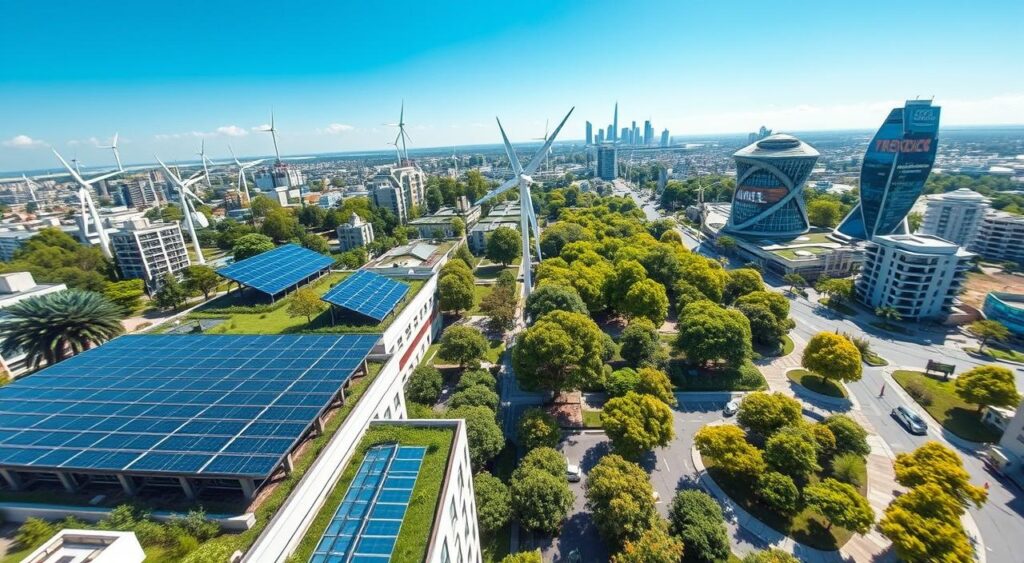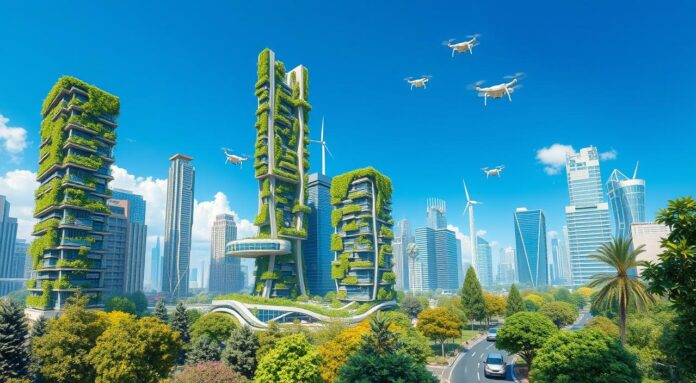Did you know that training one deep-learning model can emit up to 284,000 kg of CO2? This is like the energy five cars use over their lifetime. It shows how urgent it is to tackle AI’s environmental impact to build a sustainable future.
AI is becoming a key tool for solving environmental problems. But, it’s important to balance its benefits with its carbon footprint. AI can make things more efficient and find new solutions. Yet, the energy needed for data centres and computing is a big challenge for our environmental goals.
In this article, we’ll look at how AI and sustainability are connected. We’ll see how AI can help make our future greener while reducing its own environmental harm. You’ll learn about AI’s carbon footprint and exciting uses for sustainable resource management. This will give you a full picture of the challenges and chances ahead.
Understanding the Environmental Impact of AI Technologies
Machine learning and artificial intelligence (AI) are growing fast. It’s important to look at how they affect the environment. From data centres to AI training models, their impact is big and needs our focus.
Carbon Footprint of Data Centres and Computing
Data centres and computing are key to AI. They use a lot of energy and release a lot of greenhouse gases. In 2023, they used about 460 TWh of electricity worldwide, almost 2% of global demand.
This number is set to rise sharply after 2024. We need to find ways to make these technologies more eco-friendly.
Energy Consumption in AI Training Models
Training big AI models, like ChatGPT, needs a lot of power. They use hundreds of thousands to millions of kWh of energy. One study found that training one AI model can release over 626,000 pounds of carbon dioxide. That’s like the emissions from 300 flights from New York to San Francisco.
As AI becomes more popular, we must manage its energy use. This is key to meeting our sustainable goals.
E-waste Challenges in AI Infrastructure
AI’s growth also means more e-waste. As AI gets better, we replace old gear and throw away old parts. The World Economic Forum (WEF) says by 2050, we’ll have over 120 million metric tonnes of e-waste.
We need to tackle e-waste and make AI materials more sustainable. This is essential for a greener future.

The environmental effects of AI are complex. We must tackle the carbon footprint, energy use, and e-waste of AI. By understanding these, we can create greener AI solutions that meet our sustainable goals.
AI and Sustainability: Current Applications and Solutions
Artificial intelligence (AI) is changing how we tackle big environmental problems. It’s used in many ways, from making things greener to helping with climate change. AI is also key in using renewable energy.
AI is making a big difference in waste management. It helps sort waste better by using computer vision and learning. This means waste is recycled more efficiently.
AI is also improving energy use. It helps manage smart grids and use renewable energy better. AI looks at lots of data to find ways to use energy smarter.
AI is helping in farming too. It makes farming more efficient and reduces harm to the environment. This shows AI’s wide range of benefits for sustainability.
These examples show AI’s power in making our world greener. As we use more green AI, the future looks even brighter for a sustainable planet.
Smart Resource Management Through AI Innovation
AI is changing how we use our resources, leading to a greener future. It helps sort waste, manage water, and run energy grids better. This supports a circular economy and makes our resources last longer.
Automated Waste Sorting Systems
AI is making waste management smarter. Systems like ConvoWaste use AI to sort waste accurately. This helps recycle more and reduces landfill waste, making our environment cleaner.
Water Resource Optimisation
AI is improving water treatment. It helps manage water better, predict maintenance needs, and monitor quality. AI finds patterns in data to use water more efficiently, helping solve global water issues.
Energy Grid Management
AI is making energy grids smarter. It optimises grids, forecasts demand, and uses renewable energy better. Companies like Refiberd and Rubicon are leading this change, helping us move towards a circular economy.
AI and sustainability work together well. They use natural language processing and machine learning to manage resources better. This opens up new ways to use resources efficiently, leading to a better future.
Sustainable Material Science and AI Development
The link between AI and sustainable material science is changing the game. AI is speeding up the discovery of new materials. It’s also making production better and finding green alternatives that cut down on waste.
Companies like Protein Evolution Inc. use AI to create enzymes that break down plastics and textiles. This helps recycling a lot. The National Renewable Energy Laboratory’s PolyID tool uses AI to guess how materials will behave. This helps find sustainable plastics.
AI is also helping with climate modelling and disaster planning. It looks at lots of data to find ways to fight climate change. This shows AI’s role in making our world more sustainable, helping meet the United Nations’ goals. With eco-friendly AI practices and green computing, the future looks bright for sustainable materials.


